Top News
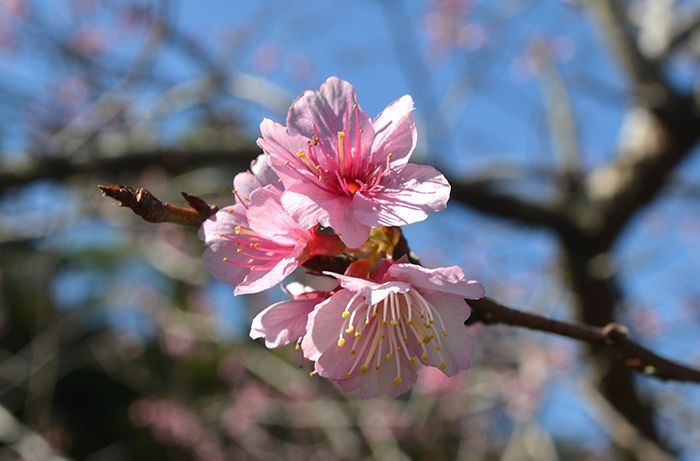
January 5, 2022 Ryukyu Shimpo
Cherry blossoms are blooming at Nago Castle Park, a famous cherry blossom spot, and nearly in full bloom at one home in Agarie, Nago City.
The residence has previously won the Sakura Suubu, Agarie’s annual community contest to compare blooming cherry blossom flowers planted along the streets and at residential homes within the district.
The resident of the same home, a woman in her 50s, smiled and commented, “cherry blossoms bring us joy.” This year, judges of the Sakura Suubu will begin deliberations on January 10.
(English translation by T&CT and Monica Shingaki)
Go to Japanese
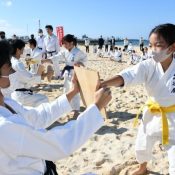
January 4, 2022 Ryukyu Shimpo
By Erina Ishii
On January 3, the Shorin Ryu Kyudokan Meihokai Kids Karate School located in Nagata in Ginowan, Okinawa, held their first practice of the new year at Tropical Beach. Approximately 80 students, from four-year-old children to adults, participated. The group was lucky to have beautiful weather, and practiced under a blue sky, feeling the ocean breeze.
After a jog on the sand, students turned their backs to the sea and practiced forms and broke boards. They worked up a sweat shouting as they practiced punches. Under the watchful eyes of their parents and guardians, students announced their goals for the new year.
Ryuto Torii is in his third year at Ginowan Senior High School and has been learning karate since first grade. He says, “I want to make it through the prefectural preliminaries for the world tournament. I also start college in the spring, so I want to prepare for that.” Akemi Hamakawa, a representative of the karate school, told the students, “Let’s do our best during practice so that we can achieve great results.”
(English translation by T&CT and Ellen Huntley)
Go to Japanese
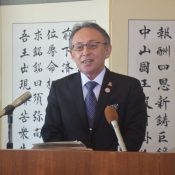
January 4, 2022 Ryukyu Shimpo
Okinawa governor Denny Tamaki delivered year-opening remarks to employees at the Okinawa Prefectural Office on January 4, and said regarding the 50th anniversary of Okinawa being reverted to Japanese control, “We will take into consideration the varied opinions of Okinawa’s residents, and investigate the manner in which we make our suggestions and declarations.” The governor compared the current state of Okinawa to the image depicted in the “Proposal of steps for the reversion of Okinawa” (also known as the “Yara Proposal”) submitted to the Japanese government by Chobyo Yara, the chief executive of the Government of the Ryukyus (at that time) before the reversion, and indicated his plan is to form a proposal or declaration that outlines a new vision for the future of Okinawa.
Tamaki explained that the Yara Proposal, “created a new vision for Okinawa, prioritizing the welfare of Okinawans, established local self-governance, was anti-war, pro-peace, established basic human rights, and constructed a framework for the basic economic development of Okinawa.”
Regarding the unending incidents, accidents, and environmental damage related to the U.S. military bases in the 50 years since the reversion, Tamaki stated, “I will work with all my power to request the Japanese government reduce the number of bases in Okinawa, revise the Japan-U.S. Status of Forces Agreement (SOFA), reduce the heavy burden created by the bases, and resolve the numerous issues the bases cause.”
The previous year was beset by the ongoing coronavirus pandemic as well as a large influx of pumice stone which clogged the bays and ports of Okinawa, and Tamaki indicated that his resolution would take these into consideration as well. Meanwhile, he touched on Okinawans who participated in the Tokyo Olympics and Paralympics this year, thanking them for “giving us all courage and inspiration.”
Tamaki closed by saying, “Heading into the fourth year of my term, I will work vigorously to administer the government of Okinawa in a way that meets the expectations of all Okinawans with a renewed spirit.”
(English translation by T&CT and Sam Grieb)
Go to Japanese
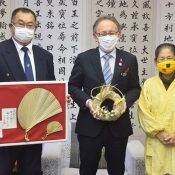
December 30, 2021 Ryukyu Shimpo
By Masaaki Umeda
The Kudakajima Yuimaru-no-kai (chaired by Yoshihisa Nishime), which aims to conserve Kudaka Island’s tradition, met with Governor Denny Tamaki at the Okinawa Prefectural Government Office on December 28 and gifted a ganshina-shimenawa, a sacred Shinto rope (shimenawa) styled as a head ring for carrying items on the head (ganshina).
In Kudaka Island where the water supply was limited, ganshina head rings were used to carry water containers on top of the head and were considered a good luck charm. Governor Tamaki responded, “Various people have supported [my work] in prefectural government the past year. I hope to expand this circle of trust in the new year as well.”
(English translation by T&CT and Monica Shingaki)
Go to Japanese
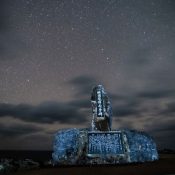
December 31, 2021 Ryukyu Shimpo
By John Matsumoto
Disrupted by the coronavirus and damaged by pumice created by an undersea volcanic explosion, Okinawa finally looks to end a tumultuous 2021.
2022 will mark the 50th anniversary of Okinawa being reverted to Japan after being under US control following the Pacific War. On December 30, just before the turning point of this important milestone, the “Monument in Commemoration of the Reversion of Okinawa to Japan,” which stands at the northernmost tip of Okinawa’s main island in Cape Hedo, Kunigami, can be seen wrapped in the starry night sky and the sound of waves crashing.
The Monument in Commemoration of the Reversion of Okinawa to Japan tells the story of Okinawa being returned to Japan, and was built in April of 1974. Yoronjima, one of Kagoshima Prefecture’s Amami islands, can be seen far off on the horizon.
As Okinawa looks toward the end of its first half-century since the reversion, it is still burdened with many of the same issues it faced at the time of the reversion, with the Japanese government’s strong-armed approach to new base construction in Henoko, and continued damage caused by the US military bases. From Okinawa’s northernmost point, the monument still casts its gaze over the island in this era much like the last one.
(English translation by T&CT and Sam Grieb)
Go to Japanese
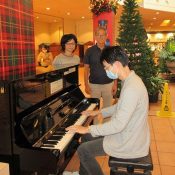
December 29, 2021 Ryukyu Shimpo
By Takeshi Kishimoto
Okinawa – On December 10, a street piano was installed in the Plaza House Shopping Center in Okinawa City. This is the first street piano in the central part of Okinawa Island.
The piano was donated by Takashi Matsumoto, a doctor from Tokyo who has lived in Okinawa City for the past four years.
Matsumoto says he studied piano for approximately 10 years starting in elementary school, but hasn’t played in a long time. However, over the course of the pandemic, he remembered the healing power of music and began practicing at Shima Piano Center in Okinawa City. He also found time between work to visit and play the pianos installed in the Naha Airport and at Cape Manzamo in Onna.
Inspired by the street pianos installed in train stations and airports around the world, and wanting a piano to play closer to home, Matsumoto spoke with Yoshinori Nagamine, the representative director of Shima Piano Center. He asked the company to restore a used piano, and got permission from the Plaza House Shopping Center to install the piano there.
The piano is located at the shopping center entrance. On the day it was installed, Matsumoto himself immediately tried out the piano, playing a rhythmic classical piece with a grin on his face.
The next to play the piano was Natsumi Hoshino, a first-year student at Okinawa University who stopped by on her way home from volunteering. She explained that she had taken lessons, but hadn’t played regularly in a long time. Nevertheless, she briskly performed the Turkish March. As shoppers sent her off with a round of applause, she smiled and said, “It was a lot of fun. I can’t wait to come back and play again.”
Mika Tamashiro is planning director at Plaza House Shopping Center. She expressed her gratitude for the donation, saying “I hope that it becomes a place where anyone can come enjoy playing the piano.”
(English translation by T&CT and Ellen Huntley)
Go to Japanese
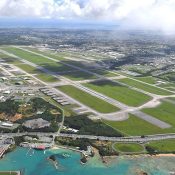
December 29, 2021 Ryukyu Shimpo
By Erina Ishii
The fourth Kadena noise lawsuit has now become the largest-scale domestic class-action lawsuit with over 35,000 plaintiffs involved. One in two of the 7,752 Kadena Town residents have become plaintiffs in this lawsuit. This is an increase compared to the third lawsuit, in which 2,836 town residents, or one in three town residents, were plaintiffs. Recognition of the lawsuit has spread, and the participation of the child-rearing generation has boosted this increase.
In Kadena Town, 80 percent of which is taken up by Kadena Air Base, the town residents are routinely troubled by noise from fighter aircraft and engine adjustment sounds from aircraft in the late night and early morning. According to the town government, in the Yara region aircraft noise occurred, on average, 46 times per one day in most months in 2021.
Tsutomu Fukuchi, the head of the Kadena branch of the plaintiffs, said, “Many town residents have noticed the abnormality of the noise and have begun to express it.” The whole of Kadena Town has a noisiness index (W value) of 75 or greater, and all of the town residents can be plaintiffs. Fukuchi mentioned, “Given that town residents are equally hurt by the noise, the number of plaintiffs is still not enough.”
The Yomitan branch of the plaintiffs accounts for 3,400 plaintiffs, which is 4.65 times the number in the third lawsuit. It has become common knowledge that residents to the north of Zakimi, Yomitan Village were judged to have the right to claim compensation in the third lawsuit, and this has opened the opportunity to be plaintiffs in the fourth lawsuit to the residents of Maeda, Onna Village.
(English translation by T&CT and Erin Jones)
Go to Japanese
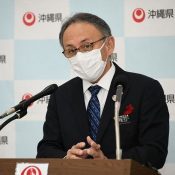
December 28, 2021 Ryukyu Shimpo
By Teppei Ikeda and Yukito Toyama
Okinawa governor Denny Tamaki gave a press conference on December 27, where he spoke on increased cases of COVID-19 in the northern part of Okinawa’s main island, as well as the spread of the omicron variant largely in and around U.S. military bases, stressing, “we are at the start of a new trend,” and once again asked Okinawans to thoroughly adhere to coronavirus prevention measures over the New Year’s holiday. The same day, five new cases were confirmed in Okinawa for people in their fifties and sixties. The governor warned that if this new wave continues to spread, “we may be forced to enact a partial shutdown.”
Governor Tamaki indicated that the new community transmitted cases could potentially be the new omicron variant, brought to the island from outside of the prefecture, and asked people to take PCR tests before travelling home for the New Year’s holiday. He asked that in order to not crowd emergency rooms, that people drink in moderation and take care of their health, and if someone begins to show symptoms such as a fever, to call the Okinawa Call Center or use the pediatric emergency care hotline (#8000).
So far, there have been 10 confirmed cases of the omicron variant in Okinawa. Additionally, there are four cases that could possibly be the omicron variant, and 8 suspected cases total. Two of the four cases are employees at Camp Hansen and Kadena Air Base. Another of the omicron cases was a family member of a Camp Hansen worker, and the final suspected omicron cases is also the family member of someone connected to the military bases.
The five new cases confirmed on December 27 each come from a different area, one in each of Northern Okinawa, Nago, Okinawa City, Ginowan, and Urasoe. Among the five cases, two are employees of the Northern Okinawa Health Department’s elderly care facility, where there was a cluster outbreak that affected 32 people (22 patients and 10 employees).
There were 11 new positive cases confirmed for people with a connection to the U.S. military. There were six cases from Kadena Air Base, and five at Camp Hansen. Camp Hansen is experiencing a cluster of around 260 cases.
(English translation by T&CT and Sam Grieb)
Go to Japanese
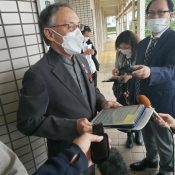
December 23 Ryukyu Shimpo
By Masaaki Umeda
Upon hearing the news on December 22 that the 2022 Okinawa Development Budget would fall below 300 billion yen for the first time in 10 years, dropping 33 billion yen to 268 billion, Okinawa governor Denny Tamaki made a statement, saying, “This budget, which is meant to become a new phase of economic development in Okinawa as it starts its 50th year [next year] since the reversion to Japan, cannot be thought to reflect the prefecture, its towns and cities, or its people.”
Tamaki commented that next year was supposed to be the start of a new phase of Okinawa’s economic development in which it would contribute to the Japanese economy, saying, “This drastic cut to the budget can only be described as very regrettable.”
In the budget is a single lump sum for which Okinawa can decide how it will be used, and this looks like it will be drastically cut by 21.9 billion yen to 76.2 billion yen. Tamaki stressed, “I wonder to what extent the development of Okinawa can be fostered with this limited budget. We continue to be completely devoted to the development of Okinawa, and its cities and towns.” Governor Tamaki gave these remarks to reporters after visiting Okinawa’s health department, which has been burdened by a new wave of coronavirus infections.
(English translation by T&CT and Sam Grieb)
Go to Japanese
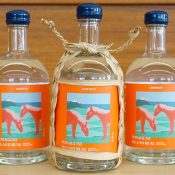
December 21, 2021 Ryukyu Shimpo
By Wu Li Jun
The Naha City-based distillery Mizuho Shuzo announced its newest creation, the Yonaguni Rum, which is made using brown sugar from Yonaguni Island. A limited quantity of 800 bottles will be marketed between December 22 and January 20. Additional bottles may be available upon request.
Mizuho Shuzo’s president Misako Tamanaha and her team announced the limited-edition rum at the JA Okinawa Kaikan in Naha City on December 20. The Yonaguni Rum is the second of the distillery’s Single Island Series, a line of eight rums each made with brown sugar from a different Okinawan island. Tamanaha said, “The product line is meant to promote the islands. We hope to boost our sugarcane growers who support the islands’ primary industry.”
Yonaguni Island Rum has a toasty aroma reminiscent of Japanese sweets like kinako (sugared soy powder) and yokan (sweet bean jelly), with herb and citrus flavors. Each bottle contains 500 milliliters of rum with 40% ABV and approximately 700 grams of local brown sugar.
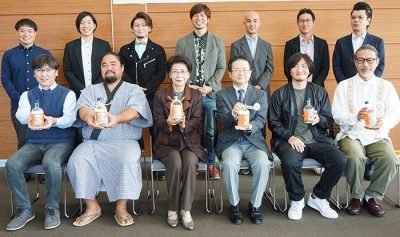
Misako Tamanaha, president of Mizuho Shuzo distillery (front row, third from left) posing for the camera at the launch of Yonaguni Island Rum at JA Okinawa Kaikan in Naha City on December20.
One hundred special edition bottles clad in Yonaguni Island’s traditional kuba leaf wrap will be made available at Mizuho Shuzo’s headquarter plant and other locations on December 22. Regular bottles will go on sale starting Jan 20, 2022. The price is 3,520 yen per bottle.
For inquiries, contact Mizuho Shuzo at (098) 885-0121.
(English translation by T&CT and Monica Shingaki)
Go to Japanese
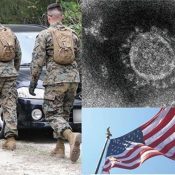
December 24, 2021 Ryukyu Shimpo
By Manato Akira and Yosuke Anri
On December 23, a representative of the United States Forces Japan (USFJ) revealed to the Ryukyu Shimpo that PCR testing requirements when leaving the United States were lifted in September of this year for servicemembers coming to any of the U.S. bases in Japan, including Camp Hansen. In response to the large cluster of infections at Camp Hansen, the military has changed its policy to require servicemembers to get tested within 72 hours prior to departing for Japan. According to the Okinawa Department of Public Health and Medical Care, the U.S. Naval Hospital has been permitting U.S. servicemembers who are fully vaccinated to move around, not just on their base of deployment, but between bases, even during the period of restricted movement after entering Japan.
At the request of the Okinawa Municipal Council for Military Land Conversion and Base Problems (Guntenkyo Council), Governor Denny Tamaki visited the Prime Minister’s Office on December 23. He criticized the failure to enforce PCR testing. Regarding the loosening of testing requirements before departing for Japan, he said, “It’s a complete shock. I was under the impression that they were enforcing strict testing.” He called on both the U.S. and Japanese governments to enforce testing, and to carry out genomic analysis of the virus strains at the U.S. bases in Okinawa.
When asked about the decision to loosen border control measures without informing the national or prefectural governments, the USFJ representative explained “We followed the guidance of the CDC, the United States Department of Defense, and the United States Indo-Pacific Command.” The representative emphasized that they require servicemembers who have not received a negative test five days after entering Japan to wear a mask.
The USFJ plans to send samples from infected servicemembers to the United States for genomic analysis to determine whether the servicemembers have the Omicron variant. At a press conference on December 23, Chief Cabinet Secretary Hirokazu Matsuno said that genomic analysis will be required for approximately two weeks.
Governor Tamaki suggested that “in order to respond more rapidly,” the USFJ could do the analysis at the U.S. Naval hospital and get results in a day. He also indicated that the prefectural government is considering supplying reagent for the genomic analysis.
In response to the news that the national government is considering offering free PCR and antigen testing, Governor Tamaki added, “We have received word that free testing will be available in Okinawa and Osaka. We will continue to work with the national government to respond to the current situation.”
(English translation by T&CT and Ellen Huntley)
Go to Japanese












 Webcam(Kokusai Street)
Webcam(Kokusai Street)


